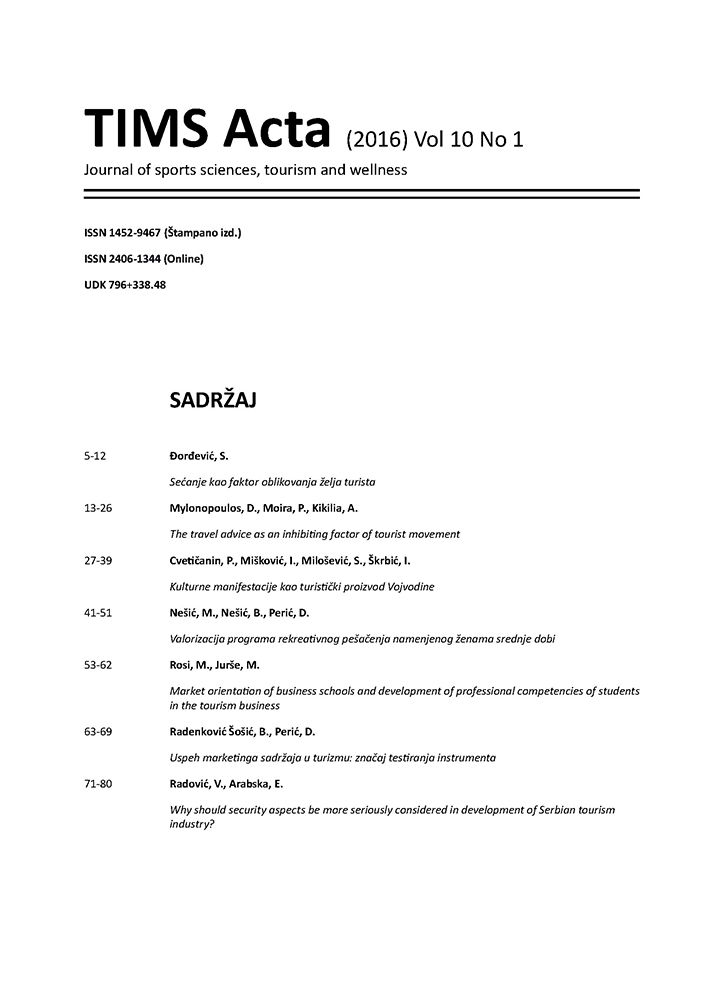WHY SHOULD SECURITY ASPECTS BE MORE SERIOUSLY CONSIDERED IN DEVELOPMENT OF SERBIAN TOURISM INDUSTRY?
Abstract
Tourism today starts to be a part of everyday life for millions of citizens all over the world. According to the Travel&Tourism Competitiveness Report 2013, security is among the critical factors determining the competitiveness of a country’s tourism industry. The most common reasons that are usually given are growing threats of terrorist acts, relatively high level of crime in the region and unknown diseases. The World Tourism Organization stated that one of the factors limiting the development of the industry is that issues related to security in tourism are not sufficiently regulated. The statistics show that the vast majority of organizations in tourism infrastructure are operating at a loss due to terrorism and natural disasters. This statement was particularly confirmed after a great decrease of tourist visits to Puket and New Orleans after the horrible natural disasters (tsunami and hurricane Katrina, respectively). The question which arising in scientific and public community is: ‘’How to provide the adequate level of security for tourists.’’ Tourism is announced as one of the priorities in future development of the Republic of Serbia. The author used the methodology appropriate for social science. The study results have indicated an urgent need for acceptance of holistic approach regarding the issue. Tourism industry has to recognize the importance of security in its daily activities and in these efforts needs to closely cooperate with security services on the local and national level.
Keywords: Risk, Security issues, Food safety, Tourism, Environmental security
References
Adeyinka-Ojo, S. F., Khoo-Lattimore, C., & Nair, V. (2014). A framework for rural tourism destination management and marketing organisations. Procedia - Social and Behavioral Sciences 144, 151 – 163
Albrechtsen, E.(2003). Security vs safety. NTNU - Norwegian University of Science and Technology. Department of Industrial Economics and Technology Management. Available at: http://www.iot.ntnu.no/users/albrecht/rapporter/notat%20safety%20v%20security.pdf. Accessed: 12/2014
Angelkova, T., Koteski, C., Jakovlev, Z., & Mitrevska, E. (2012). Sustainability and competitiveness of tourism. Procedia - Social and Behavioral Sciences 44, 221 – 227
Anuar, A. N. A., Bookhari, S. N., & Aziz, N. A. (2012). The Effectiveness of Safe City Programme as Safety Basic in Tourism Industry: Case Study in Putrajaya. Procedia - Social and Behavioral Sciences 42, 477 – 485
Baldigara, T., & Mamula, M. (2012). Tourism statistics in Croatia: Present status and futurechallenges. Procedia - Social and Behavioral Sciences 44, 53 – 61
Gabor, M. R., Codrina, L., & Oltean F. D. (2012). A comparative analysis regarding European tourismcompetitiveness: emerging versus developed markets. Procedia Economics and Finance 3, 361 – 366
Jucan, C. N., & Jucan, M. S. (2013). Travel and tourism as a driver of economic recovery. Procedia Economics and Finance 6, 81 – 88
Wilks, J., & Moore, S. (2004). Tourism Risk Manangement for the Asia Pacific Region: An Autorative Guide for the Managing of Crises and Disasters. Report prepared by the APEC International Centre for Sustainable Tourism, 110pp.
Kamble, Z., & Bouchon, F. (2014).Tourism planning and a nation’s vision: A review of the tourismpolicy of Sri Lanka. Procedia - Social and Behavioral Sciences 144, 229 – 236
Kôvári, I., & Zimányi K. (2011). SAFETY AND SECURITY IN THE AGE OF GLOBAL TOURISM (The changing role and conception of Safety andSecurity in Tourism). Applied Studies in Agribusiness and Commerce – APSTRACT. Agroinform Publishing House, Budapest, 59-61
Kingdom of Thailand. (2007). Disaster Prevention and Mitigation Act B.E. 2550 [A.D. 2007]
Maximiliano, K. (2014). Foreword Two: Problems of Tourism Safety in Latin America. In: Tourism Security. Strategies for Effectively Managing Travel Risk and Safety by Peter Tarlow. Available at: http://www.sciencedirect.com/science/book/9780124115705. Accessed: 12/2014
Masfeld, Y, & Pizam, A. (2005). Tourism, security and safety from theorz to practice. Elsevier.
Petrović-Ranđelović, M., & Miletić, D. (2012). (No) Competitiveness and Sustainable Development of Serbian Tourism. Procedia - Social and Behavioral Sciences 44, 78 – 87
Prashyanusorn, V., Kaviya, S., & Yupapin, P. P. (2010). Surveillance system for sustainable tourism with safety and privacy protection. Procedia Social and Behavioral Sciences 2, 74–78
Radović V. (2010). Concept of risk manangement from natural distaers in Serbian tourism industry, Journal Poslovna ekonomija, EDUCONS University, Sremska Kamenica, volume 6 (4): 65-74.
Serbian Government. (2006). Strategy of tourism development in the Republic of Serbia Available on http://www.srbija.gov.rs/vesti/dokumenti_sekcija.php?id=45678. Retrieved on 3td January 2015.
Serbia Travel & Tourism Development Potential 2011-2023. World Travel and Tourism Council. Available at: http://www.serbia.travel/download/WTTC_Serbia_Report.pdf. Accessed: 12/2014
Susmayadi, I Made, Sudibyakto, H., Kanagae, Adiyoso, W., & Suryanti, E. D. (2014). Sustainable Disaster Risk Reduction through Effective RiskCommunication Media in Parangtritis Tourism Area, Yogyakarta. Procedia Environmental Sciences 20, 684 – 692
Travel & Tourism Competitiveness Report 2013. Reducing Barriers to Economic Growth and Job Creation. Blanke, J., & Chiesa, T., editors. World economic forum. Available at: http://www.weforum.org/reports/travel-tourism-competitiveness-report-2013. Accessed: 12/2014
Yang, C. L., & Nair, V. (2014). Risk perception study in tourism: Are we really measuring perceived risk? Procedia - Social and Behavioral Sciences 144, 322 – 327
The United Environmental Programme (UNEP) in cooperation with the Caribbean Alliance for Sustainable Tourism (CAST). (2008). Disaster Risk Management For Coastal Tourism Destinations Responding To Climate Change, A Practical Guide For Decision Makers, France. Available on: http://www.unep.fr/shared/publications/pdf/DTIx1048xPA-DisasterRiskManagementforCoastalTourism.pdf. Retrieved on 10th January 2015.
- Autori zadržavaju autorska prava i pružaju časopisu pravo prvog objavljivanja rada i licenciraju ga "Creative Commons Attribution licencom" koja omogućava drugima da dele rad, uz uslov navođenja autorstva i izvornog objavljivanja u ovom časopisu.
- Autori mogu izraditi zasebne, ugovorne aranžmane za neekskluzivnu distribuciju članka objavljenog u časopisu (npr. postavljanje u institucionalni repozitorijum ili objavljivanje u knjizi), uz navođenje da je članak izvorno objavljen u ovom časopisu.
- Autorima je dozvoljeno i podstiču se da postave objavljeni članak onlajn (npr. u institucionalni repozitorijum ili na svoju internet stranicu) pre ili tokom postupka prijave rukopisa, s obzirom da takav postupak može voditi produktivnoj razmeni ideja i ranijoj i većoj citiranosti objavljenog članka (Vidi Efekti otvorenog pristupa).

